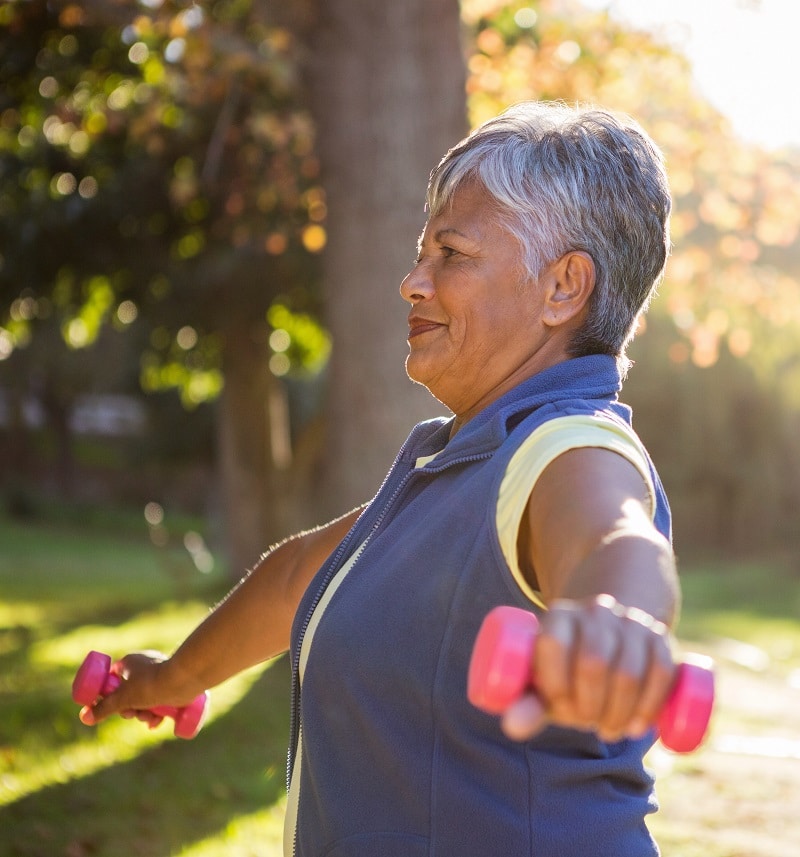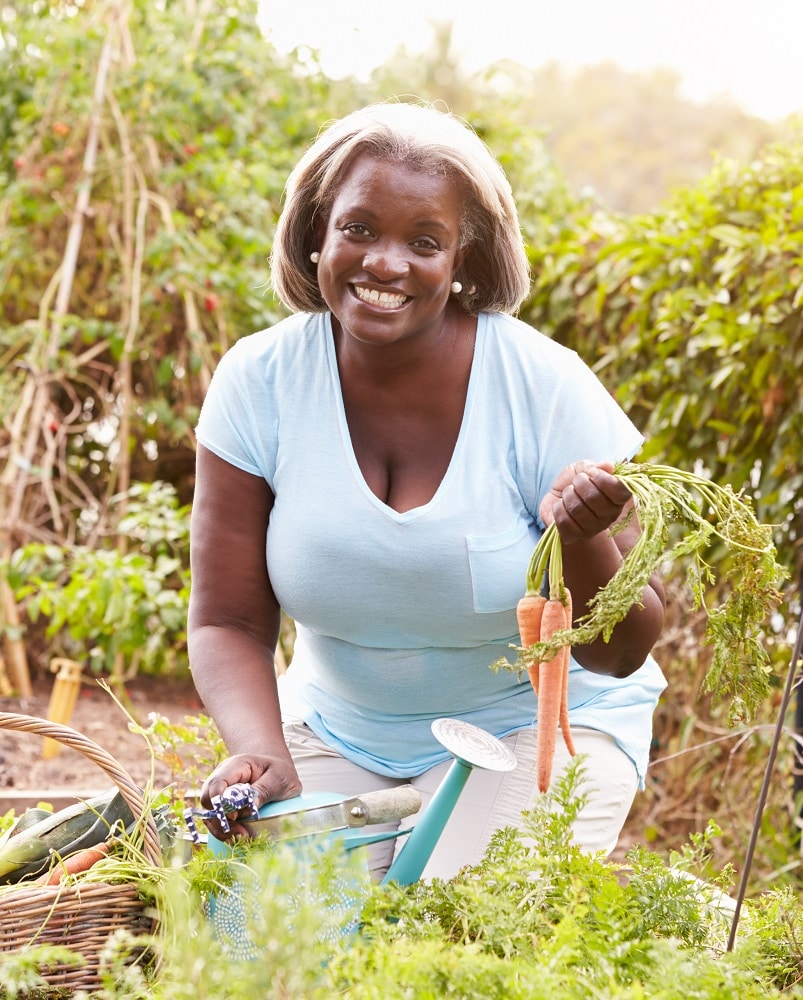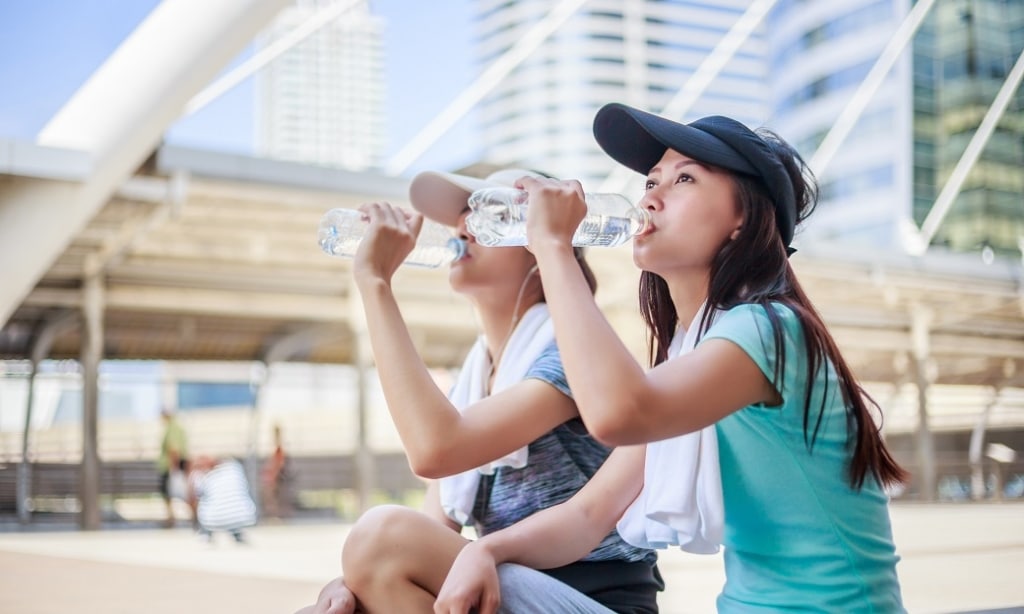What to do (and what to avoid)
Moving More can include many activities, such as these:
- Walking or hiking
- Gardening, yard work, or housework
- A workout at a gym
- Recreational activities such as dancing, bicycling, swimming, skiing, or martial arts
- Group aerobic activities such as Zumba
- Participation in active sports such as tennis, soccer, or basketball
- Movement therapies such as yoga, qigong, and tai chi

Adding more movement to your daily activities is a good way to start Moving More.
Improve your muscle mass and density
Higher muscle mass and density are linked to better survival. They’re also linked to better outcomes after surgery.
Muscle density improves when fat embedded in muscle fibers is reduced.1Myers B. How to increase muscle density. Livestrong. July 19, 2019. Viewed September 11, 2021. Both diet (protein intake) and physical activity contribute to more muscle mass, with some evidence that physical activity is especially important for women.2Alexandrov NV, Eelderink C et al. Dietary protein sources and muscle mass over the life course: the Lifelines Cohort study. Nutrients. 2018;10(10):1471.
Aerobic activity—such as moderate to vigorous walking, dancing, swimming or cycling—can improve muscle density, as can resistance training.3Koeppel M, Mathis K, Schmitz KH, Wiskemann J. Muscle hypertrophy in cancer patients and survivors via strength training. A meta-analysis and meta-regression. Critical Reviews in Oncology/Hematology. 2021 Jul;163:103371. Both types of exercise are recommended by experts.
At least a moderate-intensity activity such as brisk walking or climbing stairs is needed for the most benefit.

Moderate-intensity activity increases your heart rate and breathing rate somewhat and should cause you to perspire—a level that gets you moving fast enough or strenuously enough to burn off three to six times as much energy per minute as you do when you are sitting quietly.
Vigorous activity causes your heart rate and breathing rate to increase significantly to the point that you find it difficult to hold a conversation, burning off more than six times as much energy per minute as you do when you are sitting quietly. Examples include jogging at 6 mph, bicycling 14-16 mph, or playing basketball.
Resistance training such as weightlifting is recommended at least 2 or 3 days a week.
Aim for at least 7.5 MET-hours a week
Exercise may be measured in metabolic equivalent hours, or MET-hours. Any one of these activities would be 10 MET-hours:4Harvard Women’s Health Watch. MET-hour equivalents of various physical activities. Harvard Health Publishing. December 2009. Viewed February 27, 2019.
- 3½ hours of housecleaning
- 3 hours of brisk walking
- 2¼ hours of dancing
- 1 to 1½ hours bicycling 10-16 mph
7.5–15 MET hours (135–270 minutes of brisk walking) per week is linked to lower risks of several types of cancer.5Matthews CE, Moore SC et al. Amount and intensity of leisure-time physical activity and lower cancer risk. Journal of Clinical Oncology. 2019 Dec 26:JCO1902407. This is in line with the recommendation to aim for a minimum of 150 minutes of moderate or 75 minutes of vigorous physical activity a week from the American Cancer Society, American Institute for Cancer Research, and the US Department of Health and Human Services. See Expert recommendations ›

Stay active during cancer treatment and beyond
You may need to adjust movement types and levels during or after treatments such as surgery, chemotherapy or radiation. Following your doctor’s advice is important, but even within restrictions most people can increase their level of activity and receive the benefits.
Even a little activity is better than none. Increasing light-intensity activities such as light housekeeping, light gardening, and leisurely walking slowed the decline of physical function in older cancer survivors.6Blair CK, Morey MC et al. Light-intensity activity attenuates functional decline in older cancer survivors. Medicine and Science in Sports and Exercise. 2014 Jul;46(7):1375-83.

Stay hydrated
If you increase your activity levels, especially if you work up a sweat, you’ll probably need to pay more attention to staying hydrated.
Maintaining optimal levels of fluid in your body can bring you these benefits:7How to stay hydrated during cancer treatment. Cancer Treatment Centers of America. June 10, 2020. Viewed September 11, 2021.

- Prevent the unpleasant and even dangerous symptoms of dehydration
- Optimize your digestion, hormone balance, immune system function, inflammation and other body terrain factors
- Allow your body to flush out toxic substances
- Reduce treatment side effects, such as nausea, weakness, constipation, and fatigue
- Contribute to a general sense of well-being
For people with cancer, dehydration may cause your treatment to be delayed until you can be rehydrated, so staying hydrated is an important consideration in your treatment.
Stay hydrated with water or unsweetened beverages, and avoid caffeine and alcohol if you’re at risk for dehydration.
Move safely
Physical activity involves the risk of injury. Build your strength and balance as you gradually increase your exercise, paying attention to proper technique.8Harvard Women’s Health Watch. 10 tips to prevent injuries when you exercise. October 2013. Harvard University. Viewed August 29, 2021.
A few cautions are noted:9Stevinson C, Campbell A, Cavill N, Foster J. Physical activity and cancer: a concise evidence review. Macmillan Cancer Support. 2015; Dixon A. Absolute Contraindications to Physical Activities in Geriatric Patients. Livestrong.com. August 14, 2017. Viewed September 8, 2021.
- Avoid high-intensitya level that gets you moving fast enough or strenuously enough to burn off more than six times as much energy per minute as you do when you are sitting quietly; examples include jogging at 6 mph, bicycling 14-16 mph, or playing basketball activities when immunosuppressedpartial or complete suppression of the immune response, or when experiencing pain, severe fatigue, or compromised bone health.
- Avoid activities requiring balance when frail or experiencing dizziness or peripheral sensory neuropathy.
- Anyone with a stoma should start with low resistance exercise and progress slowly to avoid herniation.
- Exercise could be a problem if you have some health conditions such as heart conditions or deep vein thrombosis (DVT).
- Avoid exercise during bouts of vomiting, nausea, and diarrhea.
- You may be advised not to exercise on days of chemotherapy treatments or for 24 hours afterward.

Seek the advice of your healthcare professional before undertaking a new or increased exercise routine.
Moderate-intensity exercise is associated with a more pro-inflammatory immune state, resulting in increased oxidative DNA damage.10Gao R, Yu T et al. Exercise intervention for post-treatment colorectal cancer survivors: a systematic review and meta-analysis. Journal of Cancer Survivorship. 2020 Dec;14(6):878-893. This doesn’t mean that exercise is bad, but that you may need to work up from low-intensity to moderate-intensity exercise if you’re not currently physically fit. “Although short-term, intensive exercise raises oxidative stressan imbalance between free radicals and antioxidants in your body; this imbalance can cause harmful oxidation reactions in your body chemistry, developing a routine with regular moderate workouts will reduce it over time.”11Block KI. Life over Cancer: The Block Center Program for Integrative Cancer Treatment. New York: Bantam Dell. 2009. p. 309.
How Moving More relates to other healing practices and lifestyle choices in cancer
Sharing Love and Support
For many people, sharing a physical activity—whether a yoga class, a walk on the beach, or dancing—with a loved one makes the activity a social event and often more pleasurable. Social physical activity may help a person with cancer enjoy Moving More even when their energy level is low. Practicing with a “purpose partner” may increase the likelihood that you will maintain physical activity.
Helpful links
Keep reading
Moving More
More Healing Practices
Learn more
References
